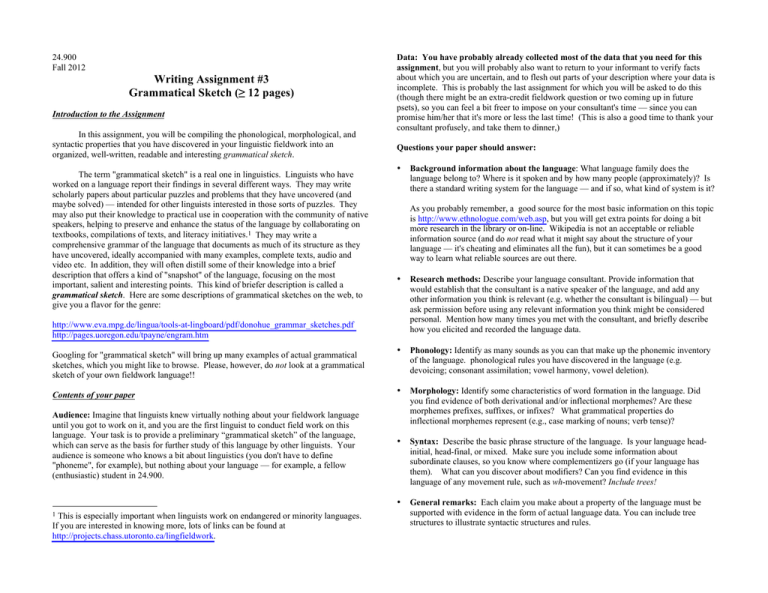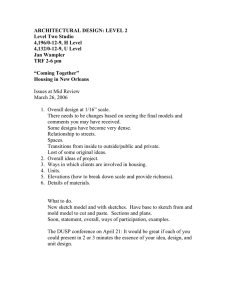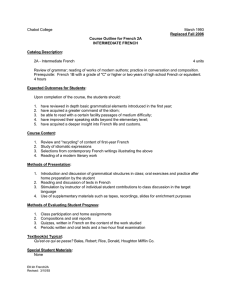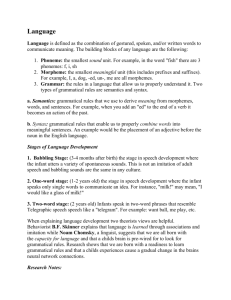24.900 Fall 2012
advertisement

24.900 Fall 2012 Writing Assignment #3 Grammatical Sketch (≥ 12 pages) Introduction to the Assignment In this assignment, you will be compiling the phonological, morphological, and syntactic properties that you have discovered in your linguistic fieldwork into an organized, well-written, readable and interesting grammatical sketch. The term "grammatical sketch" is a real one in linguistics. Linguists who have worked on a language report their findings in several different ways. They may write scholarly papers about particular puzzles and problems that they have uncovered (and maybe solved) — intended for other linguists interested in those sorts of puzzles. They may also put their knowledge to practical use in cooperation with the community of native speakers, helping to preserve and enhance the status of the language by collaborating on textbooks, compilations of texts, and literacy initiatives.1 They may write a comprehensive grammar of the language that documents as much of its structure as they have uncovered, ideally accompanied with many examples, complete texts, audio and video etc. In addition, they will often distill some of their knowledge into a brief description that offers a kind of "snapshot" of the language, focusing on the most important, salient and interesting points. This kind of briefer description is called a grammatical sketch. Here are some descriptions of grammatical sketches on the web, to give you a flavor for the genre: http://www.eva.mpg.de/lingua/tools-at-lingboard/pdf/donohue_grammar_sketches.pdf http://pages.uoregon.edu/tpayne/engram.htm Googling for "grammatical sketch" will bring up many examples of actual grammatical sketches, which you might like to browse. Please, however, do not look at a grammatical sketch of your own fieldwork language!! Contents of your paper Audience: Imagine that linguists knew virtually nothing about your fieldwork language until you got to work on it, and you are the first linguist to conduct field work on this language. Your task is to provide a preliminary “grammatical sketch” of the language, which can serve as the basis for further study of this language by other linguists. Your audience is someone who knows a bit about linguistics (you don't have to define "phoneme", for example), but nothing about your language — for example, a fellow (enthusiastic) student in 24.900. 1 This is especially important when linguists work on endangered or minority languages. If you are interested in knowing more, lots of links can be found at http://projects.chass.utoronto.ca/lingfieldwork. Data: You have probably already collected most of the data that you need for this assignment, but you will probably also want to return to your informant to verify facts about which you are uncertain, and to flesh out parts of your description where your data is incomplete. This is probably the last assignment for which you will be asked to do this (though there might be an extra-credit fieldwork question or two coming up in future psets), so you can feel a bit freer to impose on your consultant's time — since you can promise him/her that it's more or less the last time! (This is also a good time to thank your consultant profusely, and take them to dinner,) Questions your paper should answer: • Background information about the language: What language family does the language belong to? Where is it spoken and by how many people (approximately)? Is there a standard writing system for the language — and if so, what kind of system is it? As you probably remember, a good source for the most basic information on this topic is http://www.ethnologue.com/web.asp, but you will get extra points for doing a bit more research in the library or on-line. Wikipedia is not an acceptable or reliable information source (and do not read what it might say about the structure of your language — it's cheating and eliminates all the fun), but it can sometimes be a good way to learn what reliable sources are out there. • Research methods: Describe your language consultant. Provide information that would establish that the consultant is a native speaker of the language, and add any other information you think is relevant (e.g. whether the consultant is bilingual) — but ask permission before using any relevant information you think might be considered personal. Mention how many times you met with the consultant, and briefly describe how you elicited and recorded the language data. • Phonology: Identify as many sounds as you can that make up the phonemic inventory of the language. phonological rules you have discovered in the language (e.g. devoicing; consonant assimilation; vowel harmony, vowel deletion). • Morphology: Identify some characteristics of word formation in the language. Did you find evidence of both derivational and/or inflectional morphemes? Are these morphemes prefixes, suffixes, or infixes? What grammatical properties do inflectional morphemes represent (e.g., case marking of nouns; verb tense)? • Syntax: Describe the basic phrase structure of the language. Is your language headinitial, head-final, or mixed. Make sure you include some information about subordinate clauses, so you know where complementizers go (if your language has them). What can you discover about modifiers? Can you find evidence in this language of any movement rule, such as wh-movement? Include trees! • General remarks: Each claim you make about a property of the language must be supported with evidence in the form of actual language data. You can include tree structures to illustrate syntactic structures and rules. -2You have probably reported most of this information in psets over the past few months, so do not be afraid of repeating yourself — but make sure that you have taken into account any comments or corrections that you received on those psets! As always, you have probably found some phenomena that are puzzling and that you aren’t sure how to describe or explain. That’s fine! That’s a hallmark of original research. Feel free to include those phenomena, pointing out what’s puzzling and suggesting possible analyses. What you focus on will depend on the particular language you’re investigating. You should pursue what is most revealing and what you find most interesting. Organizing and formatting the paper This is a research paper, not an essay. The format will therefore differ from that of the previous two papers. Your paper should include (at least) the following sections, with headings identifying each section: 1. Introduction (1-2 paragraphs) Briefly describe the purpose and scope of the paper. Give background about the language. 2. Methods (1-2 paragraphs) 3. Phonology 4. Morphology 5. Syntax 6. Conclusion (1-2 paragraphs) There are a couple of ways you could conclude the paper: (1) consider how your findings might relate to general issues discussed in class; or (2) suggest some directions for further research on this language, given some of your results. The lengths of sections 3-5 will vary and will depend on your particular language, what you discover, and what you choose to focus on. The paper should be either 1.5 or double-spaced. Its length should be no less than 12 pages (thus fulfilling MIT's CI-H requirements), but since we are asking you to report the data that supports your description, you will probably find that your own writing plus your data will somewhat exceed the 12-page minimum. The important thing is to write an excellent, informative grammatical sketch that answers the questions we want you to answer. MIT OpenCourseWare http://ocw.mit.edu 24.900 Introduction to Linguistics Fall 2012 For information about citing these materials or our Terms of Use, visit: http://ocw.mit.edu/terms.








